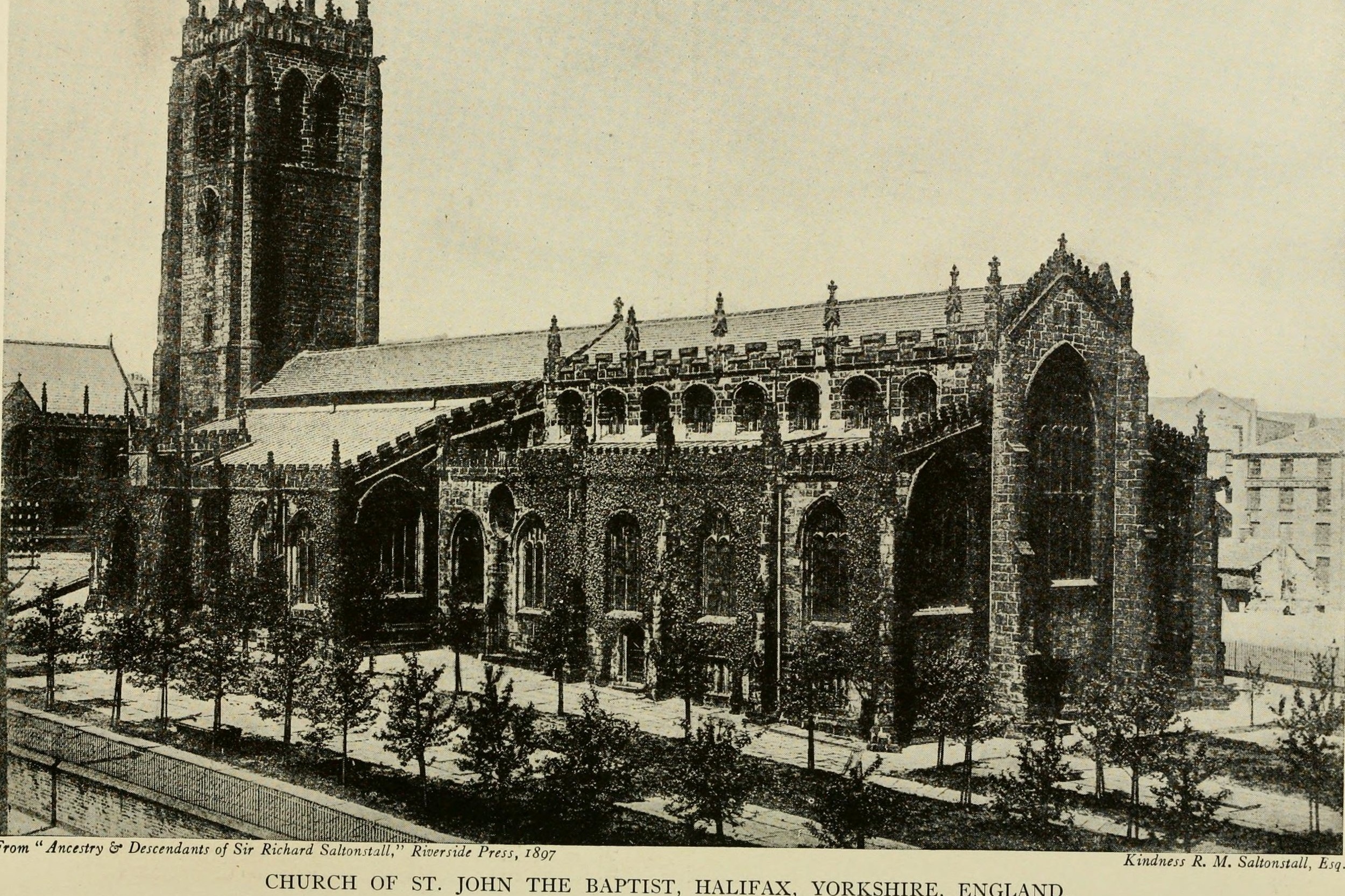Seventeenth Century West Riding, Yorkshire, England of Fairbanks and Prescott
Thanks to our guest contributor, Shawnee Korff, ninth great granddaughter of Jonathan and Grace Fairbanks and John and Mary Prescott for this post. She traveled to Yorkshire and Lancashire counties of England in the spring of 2018 to learn more about the places our forefathers came from before emigrating to New England. Through her descriptions and pictures, you will learn more about the families before they came to America.
If you visit England’s Halifax Parish in the West Riding to discover the England our 1600s ancestors knew, you will not be disappointed. That area, now called Calderdale, has many structures from 400 years ago. They are still part of the life of the Halifax people. The poet, John Betjeman, described Halifax as a town of hidden beauty. https://www.yorkshirelife.co.uk/out-about/places/the-classical-buildings-of-halifax-west-yorkshire-1-1865670
The Fairbanks and Prescott families from Sowerby and Warley were five miles of Halifax. Both in the parish of Halifax, they would visit the Halifax markets and fayers (fairs). Markets were held on Saturday, Tuesday, and Thursday. Fairs were held in August and November. At the markets raw wool was purchased for weaving and woven goods were sold. Products such as tobacco, coffee, chocolate, and tea could be purchased. Cattle for slaughter were available in November. At the fairs lacquered furniture, silver, crystal, and porcelain were available.
The Parish Church of Halifax
Dominating the Halifax landscape in 1600 was the St. John’s Parish Church, built at the end of the Middle Ages (1100-1453). It is the oldest building in Halifax. During the Middle Ages stone construction was reserved for churches. St. John’s Church (now Halifax Minster) was built in 1438. The tower was added in 1450. It incorporated the south wall of a Norman church that was built there in 1150. https://en.m.wikipedia.org/wiki/Halifax_Minster This is where the marriages of Jonathan and Grace Fairbanks and John and Mary Prescott were recorded.
Tudor Architectural Style of Halifax
Stroll around Halifax and you will see other jewels which survived. The Cali Coffee House invites visitors to sit and take in the Tudor style. The 1500s half-timber with its bright red color ( red soil covered the timbers to preserve it) created a colorful city scape. This was the typical construction of that time. It is documented in a drawings of the White Swan Hotel by an unknown artist and on Malcolm Bull’s Calderdale Companion in a series of drawings of Halifax in the 1600s. http://www.calderdalecompanion.co.uk/
White Swan Hotel Halifax England
Malcom Bull’s Calderdale Champion
Prosperity of Wool Trade Created the Halifax Style
During the 1500s, Halifax led the way for West Riding of Yorkshire to become England's third most prosperous woolen textile manufacturing district. https://www.calderdale.gov.uk/wtw/timeline/1500-1600/1500-1600-1.html This was partially due to the “Halifax Act of 1555” which allowed every household to become an independent entrepreneur.
Hall in the Woods
The act begins ....for as much as the Parish of Halifax being planted in the great waste and moors where the fertility of ground is not apt to bring forth crops nor good grass....that meant the land would only sustain a family garden and possibly cow and poultry.
The people relied on cloth making. They would go to the town of Halifax to buy wool from wool divers. Some would buy very small amounts of wool. They would carry the wool on their heads or backs to their houses, three to five miles. At home, they would convert the wool to yarn or cloth to sell. By 1555, the town of Halifax had grown to 500 households.
Sibden Hall Halifax Yorkshire England
Because of the prosperity of the woolen industry, the number of yeoman (home or land owners) houses in Calderdale was unrivaled in the north of England. Yeomen used the wealth they accumulated from textiles to build houses that reflected their position at the top of the local society.
Architectural historians call the distinctive regional style “Halifax Houses.” These homes were built from dressed stone from the Pennine Mountains. At times, they added onto present Tudor styleportion with the new gritstone construction. The houses were built to accommodate the weaving industry.
Windows were a Distinction of the Halifax Style
One distinct feature of the Halifax houses was mullioned windows. These windows had vertical elements that supported the glass. Another was the circular rose window that was positioned above the doorway in a double story porch.
Spinning and weaving was located on the upper floor of these houses. Light streamed in the row of mullioned windows even late in the day. Lower rooms of the house were used for wool storage, kitchens, and dining halls.
Today’s visitors are welcomed at the Kershaw House built by James Mugatroyd before 1650. It is a wonderful example of the “Halifax” style.
Kershaw House in Luddendun, Halifax Parish, West Riding, Yorkshire, England
Saying Goodbye to the Seventeenth Century
The architecture of the Halifax area is nationally importance. The hills and moors which surround it provide a romantic backdrop. Before you leave Halifax, step into the Union Cross Inn, the oldest pub in Halifax. Surely, Jonathan Fairbanks and John Prescott would have raised a pint of hard apple cider, before departing to their homes in Sowerby village.
“Halifax has a beauty born of industry and one which displays grandeur with typical Yorkshire matter of factness. This is not beauty for beauty’s sake, this is beauty with purpose, a thinking man’s beauty.” https://www.yorkshirelife.co.uk/out-about/places/the-classical-buildings-of-halifax-west-yorkshire-1-1865670
In the language of the day, the men of Halifax were called “clothiers of the meanest sort.” This was a compliment. Meanest indicated that the people of Halifax were noted for their frugal living and ceaseless toil in the wool industry. This attitude provided them “the necessities of life without it superfluities.”
If you walk the paths that Jonathan and John walked, there are many hidden beautiful structures from the 1600s in the hills surrounding Halifax.
Even though this architecture was prominent in Jonathan’s homeland in England, he didn’t choose it for his house in New England. The Fairbanks House https://fairbankshouse.org/ was built in the style of southeastern England. This is probably due to the carpenters and materials available.
I’ve enjoyed the walk with you through historical Halifax as the Fairbanks and Prescott families would have seen it. You may want to visit West Yorkshire, England, yourself someday.
Coming Up…
Why would the Fairbanks and Prescott families leave their homeland, friends, relative, jobs, and security for the unknown and untried New England Colony? Next up, Seventeenth Century Turmoil in England.















